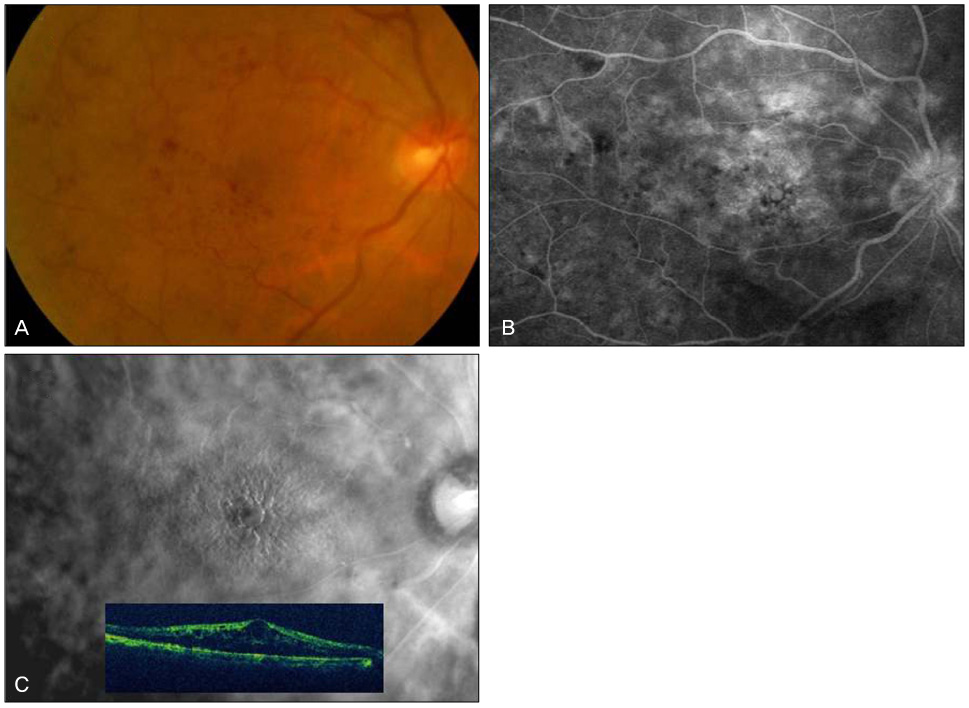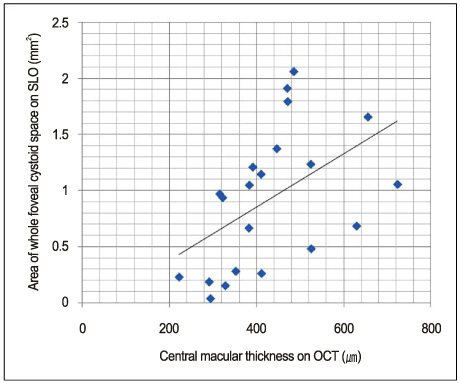J Korean Ophthalmol Soc.
2012 Apr;53(4):536-543.
Cystoid Macular Edema Detected by Scanning Laser Ophthalmoscopy in Retro-Mode
- Affiliations
-
- 1Department of Ophthalmology, Hanyang University College of Medicine, Seoul, Korea. brlee@hanyang.ac.kr
Abstract
- PURPOSE
To investigate the visualization of cystoid macular edema (CME) using noninvasive retromode imaging by a new scanning laser ophthalmoscope (SLO) and compare to previous imaging modalities.
METHODS
The authors of the present study retrospectively reviewed the medical records of 21 eyes of 20 patients with CME due to various etiologies. All eyes were examined with fundus camera, fluorescein angiography (TRC-50EX, Topcon, Tokyo, Japan), SLO (F-10, Nidek, Gamagori, Japan), and spectral-domain optical coherence tomography (OCT) (3D OCT-1000, Topcon, Tokyo, Japan). In the present study the SLO was used in the retro-mode with an infrared laser.
RESULTS
Previous fundus photography could not detect CME adequately although SLO retro-mode could show numerous oval or polygonal cystoid spaces more readily. Furthermore, each individual small cystoid space could be detected and the area of each cystoid space could be measured. The area of the largest cystoid space showed a correlation with its height, as measured with OCT (R = 0.606, p = 0.004). The area of the whole foveal cystoid space showed a correlation with central macular thickness, as measured with OCT (R = 0.493, p = 0.023).
CONCLUSIONS
A new commercially available SLO (F-10) in the retro-mode can allow us to detect each cystoid space non-invasively and to measure the extent of CME.
Keyword
MeSH Terms
Figure
Reference
-
1. Rotsos TG, Moschos MM. Cystoid macular edema. Clin Ophthalmol. 2008. 2:919–930.2. Drolsum L, Haaskjold E. Causes of decreased visual acuity after cataract extraction. J Cataract Refract Surg. 1995. 21:59–63.3. Ray S, D'Amico DJ. Pseudophakic cystoid macular edema. Semin Ophthalmol. 2002. 17:167–180.4. Cunha-Vaz JG, Travassos A. Breakdown of the blood-retinal barriers and cystoid macular edema. Surv Ophthalmol. 1984. 28:485–492.5. Brar M, Yuson R, Kozak I, et al. Correlation between morphologic features on spectral-domain optical coherence tomography and angiographic leakage patterns in macular edema. Retina. 2010. 30:383–389.6. Jittpoonkuson T, Garcia PM, Rosen RB. Correlation between fluorescein angiography and spectral-domain optical coherence tomography in the diagnosis of cystoid macular edema. Br J Ophthalmol. 2010. 94:1197–1200.7. Yamaike N, Tsujikawa A, Ota M, et al. Three-dimensional imaging of cystoid macular edema in retinal vein occlusion. Ophthalmology. 2008. 115:355–362.8. Kashani AH, Keane PA, Dustin L, et al. Quantitative subanalysis of cystoid spaces and outer nuclear layer using optical coherence tomography in age-related macular degeneration. Invest Ophthalmol Vis Sci. 2009. 50:3366–3373.9. Ikeda T, Sato K, Katano T, Hayashi Y. Examination of patients with cystoid macular edema using a scanning laser ophthalmoscope with infrared light. Am J Ophthalmol. 1998. 125:710–712.10. Beausencourt E, Remky A, Elsner AE, et al. Infrared scanning laser tomography of macular cysts. Ophthalmology. 2000. 107:375–385.11. Remky A, Beausencourt E, Hartnett ME, et al. Infrared imaging of cystoid macular edema. Graefes Arch Clin Exp Ophthalmol. 1999. 237:897–901.12. Manivannan A, Kirkpatrick JN, Sharp PF, Forrester JV. Clinical investigation of an infrared digital scanning laser ophthalmoscope. Br J Ophthalmol. 1994. 78:84–90.13. Beckman C, Bond-Taylor L, Lindblom B, Sjöstrand J. Confocal fundus imaging with a scanning laser ophthalmoscope in eyes with cataract. Br J Ophthalmol. 1995. 79:900–904.14. Woon WH, Fitzke FW, Bird AC, Marshall J. Confocal imaging of the fundus using a scanning laser ophthalmoscope. Br J Ophthalmol. 1992. 76:470–474.15. Yoshida A, Ishiko S, Akiba J, et al. Radiating retinal folds detected by scanning laser ophthalmoscopy using a diode laser in a dark-field mode in idiopathic macular holes. Graefes Arch Clin Exp Ophthalmol. 1998. 236:445–450.16. Yamamoto M, Tsujikawa A, Mizukami S, et al. Cystoid macular edema in polypoidal choroidal vasculopathy viewed by a scanning laser ophthalmoscope: CME in PCV viewed by SLO. Int Ophthalmol. 2008. 10. 15. [Epub ahead of print].17. Yamamoto M, Mizukami S, Tsujikawa A, et al. Visualization of cystoid macular oedema using a scanning laser ophthalmoscope in the retro-mode. Clin Experiment Ophthalmol. 2010. 38:27–36.18. Tanaka Y, Shimada N, Ohno-Matsui K, et al. Retromode retinal imaging of macular retinoschisis in highly myopic eyes. Am J Ophthalmol. 2010. 149:635–640.19. Ishiko S, Akiba J, Horikawa Y, Yoshida A. Detection of drusen in the fellow eye of Japanese patients with age-related macular degeneration using scanning laser ophthalmoscopy. Ophthalmology. 2002. 109:2165–2169.
- Full Text Links
- Actions
-
Cited
- CITED
-
- Close
- Share
- Similar articles
-
- Comparison of Results of Cryopexy and Laser Indirect Ophthalmoscopy in Rhegmatogenous Retinal Detachment
- Comparison of Effects of IVTA and Photocoagulation, Depending on Types of Diabetic Macular Edema
- The Effect of Intravitreal Triamcinolone Acetonide Injection according to the Diabetic Macular Edema Type
- Clinical Research on the Branch Retinal Vein Occlusion
- A Case of Secondary Macular Hole Formation after Phacoemulsification in a Vitrectomized Eye








